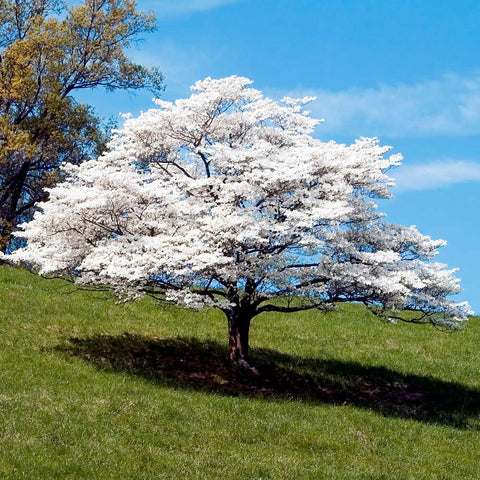In many gardening and landscaping circles, spring is king. After all, it’s the season that jumpstarts growth and sets the tone for the rest of the year. However, when it comes to planting native plants, fall is far and away the best time to get outside and get to work. This holds true across a vast region of the United States, including the South and Midwest. If you’re considering improvements to your garden, restoration of natural habitat, or a low-impact, low-maintenance landscape, native plants are an excellent option. In addition to ecological benefits and support for wildlife, native plants have a much higher rate of success when planted in the fall. The proof is in the wild! The best gardens are in complete harmony with the ecosystems surrounding them. This article will discuss the benefits of planting native plants in the fall.
Fall Planting for Success
If you’re wondering what native plants are, how they can benefit your landscape, and why fall is the perfect time to plant them, you’re in the right place. Planting native plants in the fall sets your landscape and the surrounding environment up for success. This includes ecological advantages, better root development, higher survival rates, and long-term success in the landscape. In short, planting native plants in the fall is one of the best things you can do for your garden.

What Are Native Plants?
Native plants are ones that have naturally evolved in a region over thousands of years. They have adapted to the cycles of weather, soil, and wildlife in an area – so they naturally thrive with less care and maintenance.
Native plant examples include:
Purple Coneflower (Echinacea purpurea)
Black-eyed Susan (Rudbeckia hirta)
Milkweed (Asclepias spp.)
Eastern Bluestar (Amsonia tabernaemontana)
Switchgrass (Panicum virgatum)
Bee Balm (Monarda spp.)
These plants not only provide great texture and color for the landscape, but they also provide nectar, pollen, seeds, and cover for the pollinators, birds, and beneficial insects that are native to the region.
Why Native Plants Are a Good Choice
1. Adapted to Local Conditions
Native plants are adapted to your region’s climate, rainfall, and soil conditions. This means that once they are established:
They require less watering.
Less fertilization
Greater resistance to local pests and diseases
Better performance in drought or extreme temperatures
Native plants can thrive in your landscape without as much care and maintenance as exotic or non-native plants.
2. Support Local Wildlife and Ecosystems
Native plants provide essential habitat, food, and breeding resources for native wildlife species, including pollinators like bees and butterflies, as well as birds, frogs, and beneficial insects. For example, native milkweed is the only host plant for monarch butterfly larvae, and goldenrod provides critical late-season nectar for migrating pollinators. By planting native plants, you can help restore natural food webs and promote biodiversity in your own backyard.
3. Reduce Maintenance and Chemical Use
Because they are adapted to your local conditions, native plants require less supplemental care once they are established in your landscape. They typically do not need:
Supplemental irrigation (after the first growing season)
Regular fertilization
Use of pesticides or herbicides
In addition to saving you time and money, using native plants in your landscape helps promote healthy soil, clean water, and reduced chemical runoff in the environment.
4. Prevent Erosion and Improve Soil Health
The deep, fibrous roots of many native grasses and perennials help anchor soil, improve soil structure, and increase organic matter content. These traits make native plants an excellent choice for sloped areas, riverbanks, or other sites prone to erosion.
Fall is the Best Time to Plant Native Plants
While planting native plants in the spring is an option, the long-term results are better if you plant them in the fall. The reasons fall-planted natives are set up for success include:
1. Perfect Conditions for Root Development
In the fall, the soil is still warm even as air temperatures begin to cool down. This provides the ideal environment for root growth without the stress of high heat or summer drought.
Plants can develop a strong root system before the onset of winter, which gives them a significant advantage when spring arrives. When summer heat and drought return, fall-planted natives are already ready for it.
2. Less Water Stress
In many regions of the country, fall weather is marked by increased rainfall and milder temperatures, which reduces or eliminates the need for supplemental irrigation. This is especially important for native plants, which prefer to become established slowly with minimal disturbance.
Cooler temperatures also mean that less water is lost to evaporation, so the moisture in the soil lasts longer.
3. Fewer Weeds and Pests
Fall planting means less competition from weeds, which tend to slow down and die back as the season progresses. You also avoid the flush of spring and summer pests, giving your new plants a peaceful, undisturbed start.
This allows your natives to settle in without disruption as they get established in their new home.
4. Earlier Blooms and Faster Growth in Spring
If you plant your native plants in the fall, you are essentially giving them a head start on the season. When spring arrives, the roots are already in place, so the plants can focus on top growth and flowering.
This equals earlier blooms, healthier plants, and a prettier spring garden.

Fall Planting Tips for Planting Natives
Here are a few tips to make sure your planting of natives this fall is a success.
Timing:
Plant 6 to 8 weeks before the ground freezes.
Timing:
Plant 6 to 8 weeks before the ground freezes.
Soil Prep:
Loosen the soil, remove weeds, and amend with compost if desired.
Watering:
Water in the well after planting, then water every few days for the first few weeks if rainfall is low.
Mulch:
Apply 2–3” of mulch around the base of the plant to help retain moisture and regulate soil temperature.
Label:
Mark your plantings so you will know where they are in early spring before the plants have emerged.
Native Plants to Plant in Fall
Want some ideas for great native plants to plant in the fall? Here are some of our favorites:
Native Perennials:
Echinacea (Coneflower) – Great for attracting pollinators and birds
Monarda (Bee Balm) – A favorite of hummingbirds and butterflies
Coreopsis (Tickseed) – Long-blooming and drought tolerant
Solidago (Goldenrod) – An important late-season nectar source
Asclepias (Milkweed) – The only host plant for monarch butterfly larvae
Native Grasses:
Little Bluestem (Schizachyrium scoparium)
Switchgrass (Panicum virgatum)
Indian Grass (Sorghastrum nutans)
Shrubs and Trees:
Viburnum spp. – Excellent wildlife habitat and seasonal interest
Serviceberry (Amelanchier) – Spring blooms and edible fruit
Redbud (Cercis canadensis) – Heart-shaped leaves and beautiful spring flowers

The Takeaway: Native Plants, Fall Planting
Planting native plants is at the heart of a growing movement by home gardeners, landscapers, and conservationists to return to regionally appropriate, low-impact, and wildlife-friendly gardening and landscaping. Planting native plants in the fall gives your landscape the best chance of long-term success. By choosing native plants and planting them during the cooler, wetter season of autumn, you are:
Investing in a smart landscape
Helping local ecosystems
Reducing maintenance and watering
Supporting biodiversity and pollinators
Ensuring stronger root systems and better spring growth
This fall, take a stroll around your yard, imagine your native garden design, and get outside to plant. Your landscape and the planet will thank you!




